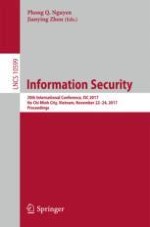2017 | OriginalPaper | Buchkapitel
Contactless Access Control Based on Distance Bounding
verfasst von : Handan Kılınç, Serge Vaudenay
Erschienen in: Information Security
Aktivieren Sie unsere intelligente Suche, um passende Fachinhalte oder Patente zu finden.
Wählen Sie Textabschnitte aus um mit Künstlicher Intelligenz passenden Patente zu finden. powered by
Markieren Sie Textabschnitte, um KI-gestützt weitere passende Inhalte zu finden. powered by
